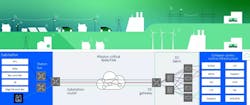Boost Disaster Resiliency by Evolving Utility Data Centers for OT Cloud
Natural disasters put intense strain on power grids. Events such as extreme storms, extended heatwaves and wildfires cause destruction and outages that can lead to costly economic damage and dangerous conditions for people and communities. As climate change increases the frequency and impact of these events, utilities face renewed pressure to improve their resiliency.
Many utilities are embracing the use of data-driven, software-centric operational technology (OT) applications to better navigate the challenges of disaster response and other high-demand pressure on their grids.
These faster and more insightful applications promise to help address the impacts of unforeseen events with more precise telemetry that is correlated across multiple asset types and delivered in near real time. However, they can’t deliver on this promise if they are interrupted, or the data is unreliable.
Utilities can ease the strain on their grids by evolving their data center operations to support modern cloud environment that is well tested in other industries already. These tighter designed cloud-based systems meet the demands of mission and operation-critical OT applications and keep them available while still being reliable.
This environment, called an OT cloud, provides capabilities that enable utilities to make their grids more resilient and ensure the fastest possible recovery from outage and disaster scenarios.
What is an OT cloud?
A utility OT cloud is a dedicated compute pool that hosts critical OT software applications and grid data in on-premises facilities such as data centers.
By deploying OT applications to their own cloud in the data center fabric, utilities can address their massive compute needs, stringent agility requirements and elastic workloads. This is highly relevant in critical environments looking to embrace digital transformation plus take advantage of convergence between IT, which has already embraced cloud, and OT where it will enable them to quickly shift OT workloads and bypass damaged infrastructure to maintain or restore service.
Unifying the approaches to both IT and OT will allow for cost savings, risk management gains and allow strained company resources to accelerate the digital transformation while making it easier to manage.
For most utilities, the next wave of OT cloud migration and deployment will focus on digital applications that can drive the transition to not just smarter grids, but truly adaptive digital smart grids.
This group includes advanced distribution management system (ADMS), energy management system (EMS) and outage management system (OMS) applications aimed at improving grid efficiency and reliability. It also includes expanded usage of synchrophasor measurement units and micro-sensors used for monitoring and control, predictive maintenance and digital twin applications.
These new adaptive smart grid applications collect large amounts of data from interconnected physical assets across the grid, then process it to optimize real-time grid monitoring, control and automation.
With an OT cloud dedicated to meeting their demands, these applications will help provide utilities with the tools for real-time awareness, while capturing the economic value these new systems bring to the utility and their customers.
How an OT cloud eases disaster recovery (and more)
A dedicated OT cloud plays a vital role in the digital infrastructure of an adaptive and resilient smart grid. It enables the utility to maintain the agile data center operations required to ensure a quick and confident recovery to any major disruption. It also builds a base for tighter integration of security layers protecting assets.
Utility leaders have always understood the benefits of moving to cloud on the IT side. Now, assessing the risks of moving to an OT cloud and again weighing the benefits can provide highly tangible benefits while modernizing the OT side.
An OT cloud also makes it easier for a utility to take advantage of new innovations to enable a more proactive approach to disaster recovery. For example, a utility can create a digital twin, or virtual replica, of the grid assets and then use it to safely test approaches to different failure scenarios.
But an OT cloud isn’t just for disasters. It can also allow a utility to combine the capabilities of physical and virtual assets to ensure a smooth response to change driven by any factor, from the demands of decarbonization to the decentralization of grid intelligence.
Essential data center fabric capabilities for OT cloud
The journey to an adaptive smart grid includes building a resilient data center fabric to facilitate corroboration of data sets across all asset types.
This means utilities gain the ability to see all interconnected OT software in the cloud with physical assets such as SCADA remote terminal units (RTUs), switch controllers and intelligent electronic devices (IEDs), thus ensuring that the data center fabric can provide essential mission-critical capabilities such as:
- Strong resiliency: The data center fabric needs to provide highly resilient communications for safety-critical OT applications such as SCADA and synchrophasor. Capabilities such as full path diversity and fast communication restoration are must-haves for avoiding disruptions.
- Deterministic QoS: The data center fabric needs flexible QoS capabilities to meet the requirements of each OT application. Building different levels of QoS can help utilities prioritize critical applications, avoid congestion and ensure consistent application performance.
- Robust cybersecurity: As part of the grid communications infrastructure, the data center fabric needs to adhere to utility-specific frameworks such as IEC 62443 (International) and NERC CIP (North America). A multi-layer security strategy is essential. It must protect the utility OT cloud, data center and services with capabilities such as end-to-end encryption, access control lists and firewall policies
Harnessing OT cloud for agile disaster recovery
An ideal solution will ensure a more agile response to disaster recovery with an open, automated data center fabric that enables seamless, end-to-end communications between on-grid IEDs and OT application software in the cloud.
It will constantly ensure the adaptive smart fabric operates in an optimal state and seamlessly extend mission-critical networking from the wide area network (WAN) and field area network (FAN) to the data center to improve resiliency, performance and security and ensure that every OT application is ready to respond in real time if disaster strikes.
The successful result allows utility leaders to rethink their approaches to OT cloud, assure operations amid changes and disruptions, provide an adaptive fabric to keep pace with their applications and the confidence to compete in the digital industry.
Ken Rabedeau is currently Head of Energy Segments for North America at Nokia. He and his team drive strategic programs in secure software and communications technologies as they impact critical industry markets for Power Utilities, Oil, Gas, Water and Mining. Ken's inventive outlook shapes his organization's long-term view of business and technology trends impacting Energy markets. He has been invited to speak and provide leadership on how technology promotes digital transformation in critical industry events worldwide. His experience in the Telecommunications and Energy industries spans over 25 years. Ken's professional acumen culminated from his roles in design, engineering, risk mitigation, management and deployment of complex digital architectures for industry leaders such as Sprint, CenturyLink and First Energy, USA. Ken has also been recognized within Nokia and Bell Labs as a Distinguished Member of Technical Staff for sustained outstanding technical contributions.
About the Author
Ken Rabedeau
Ken Rabedeau is currently Head of Energy Segments for North America at Nokia. He and his team drive strategic programs in secure software and communications technologies as they impact critical industry markets for Power Utilities, Oil, Gas, Water and Mining. Ken's inventive outlook shapes his organization's long-term view of business and technology trends impacting Energy markets. He has been invited to speak and provide leadership on how technology promotes digital transformation in critical industry events worldwide. His experience in the Telecommunications and Energy industries spans over 25 years. Ken's professional acumen culminated from his roles in design, engineering, risk mitigation, management and deployment of complex digital architectures for industry leaders such as Sprint, CenturyLink and First Energy, USA. Ken has also been recognized within Nokia and Bell Labs as a Distinguished Member of Technical Staff for sustained outstanding technical contributions.

